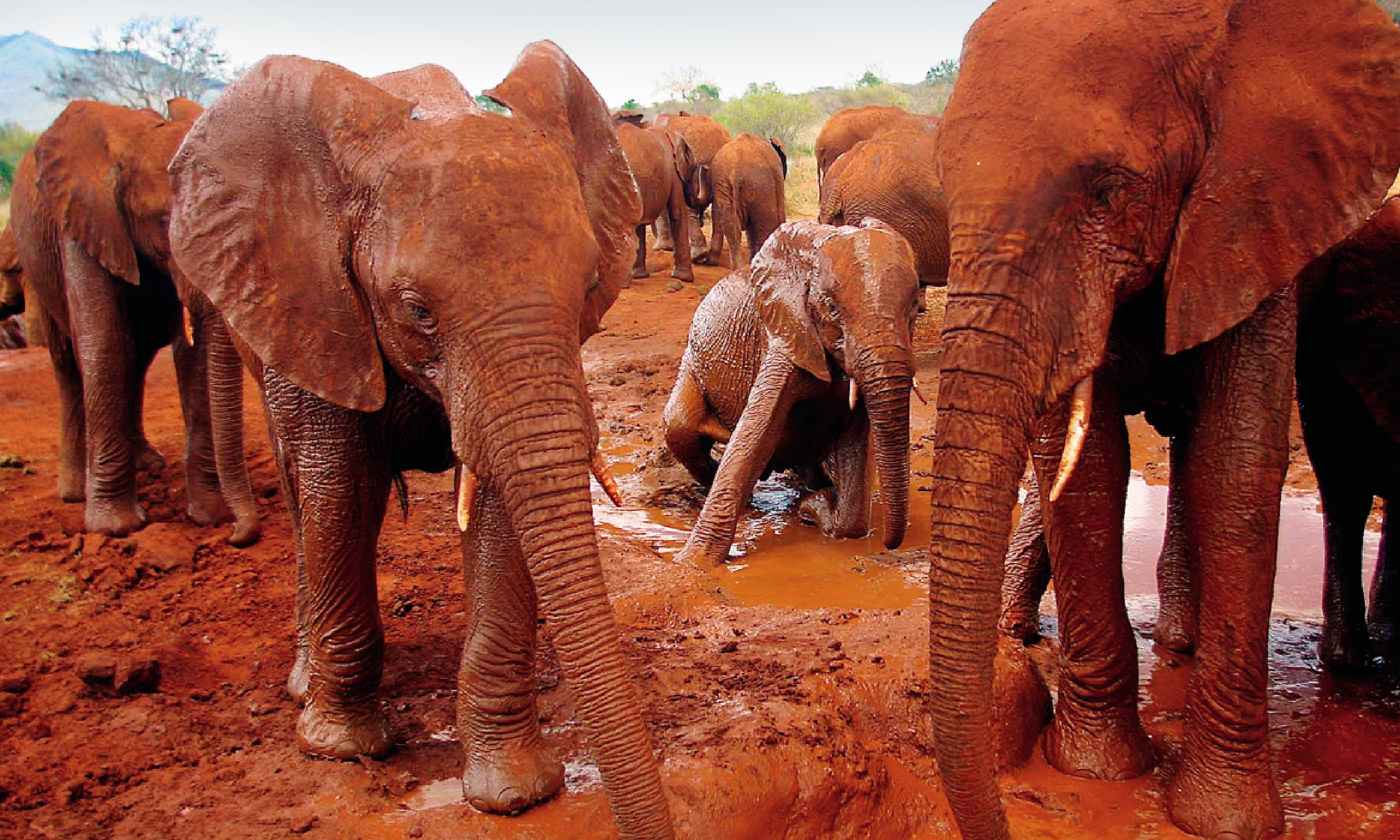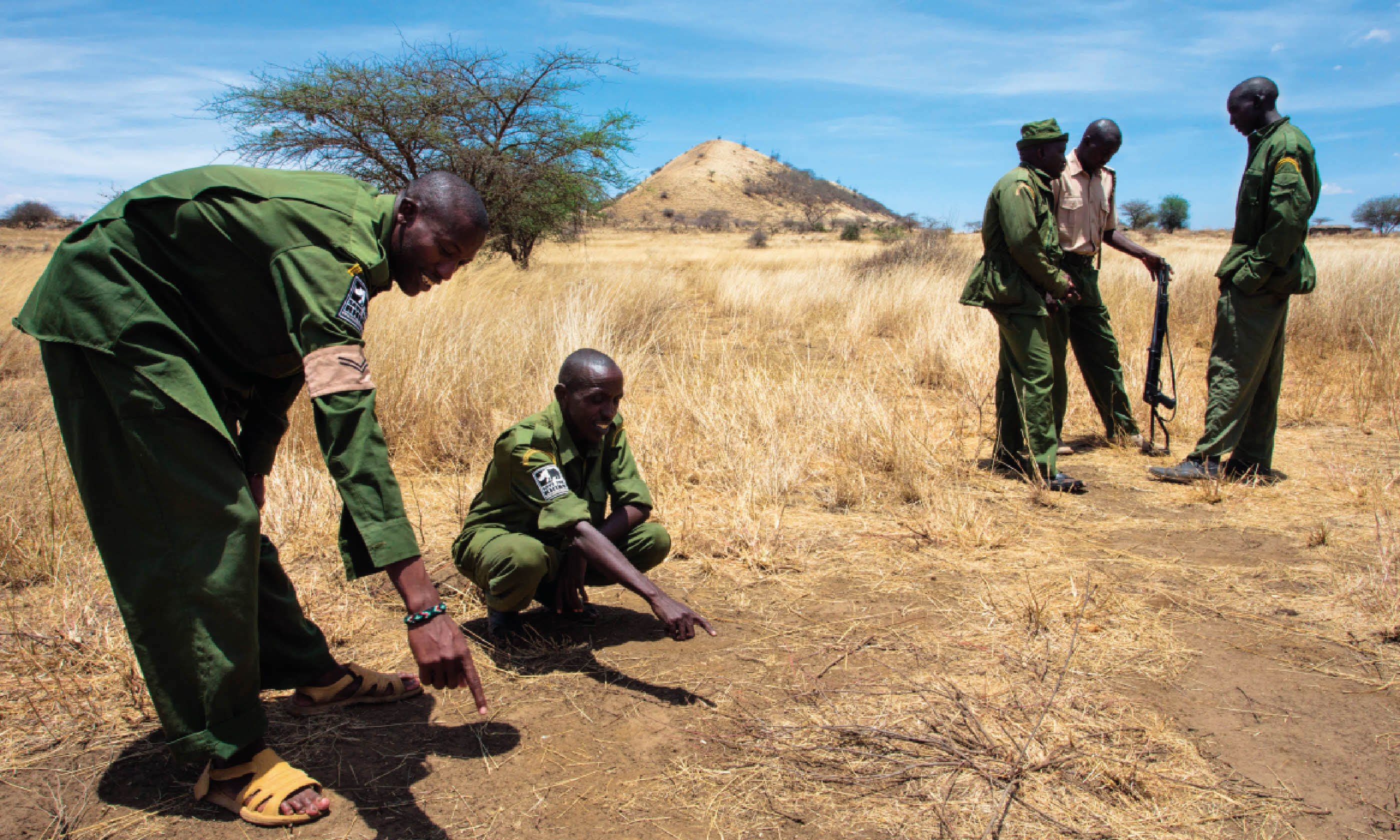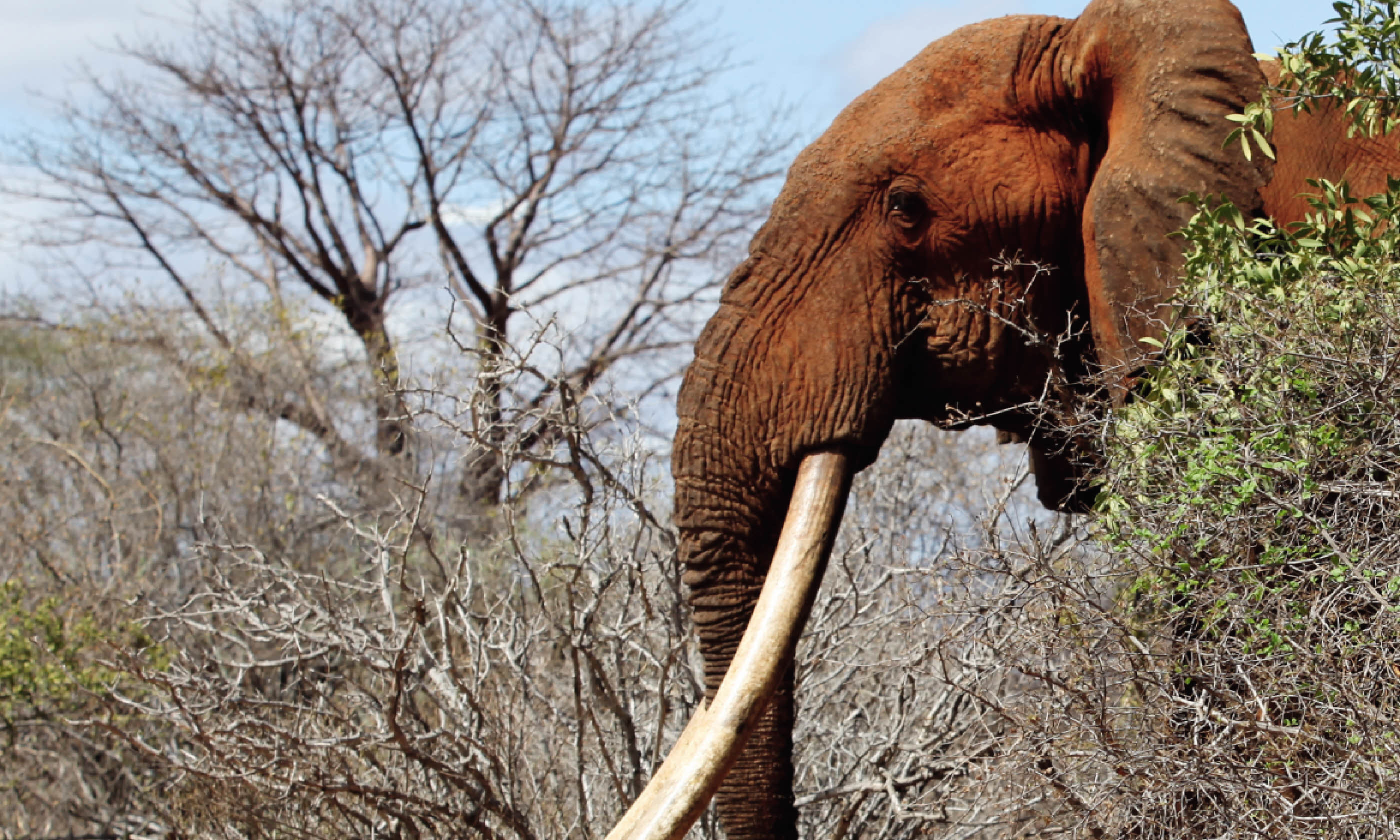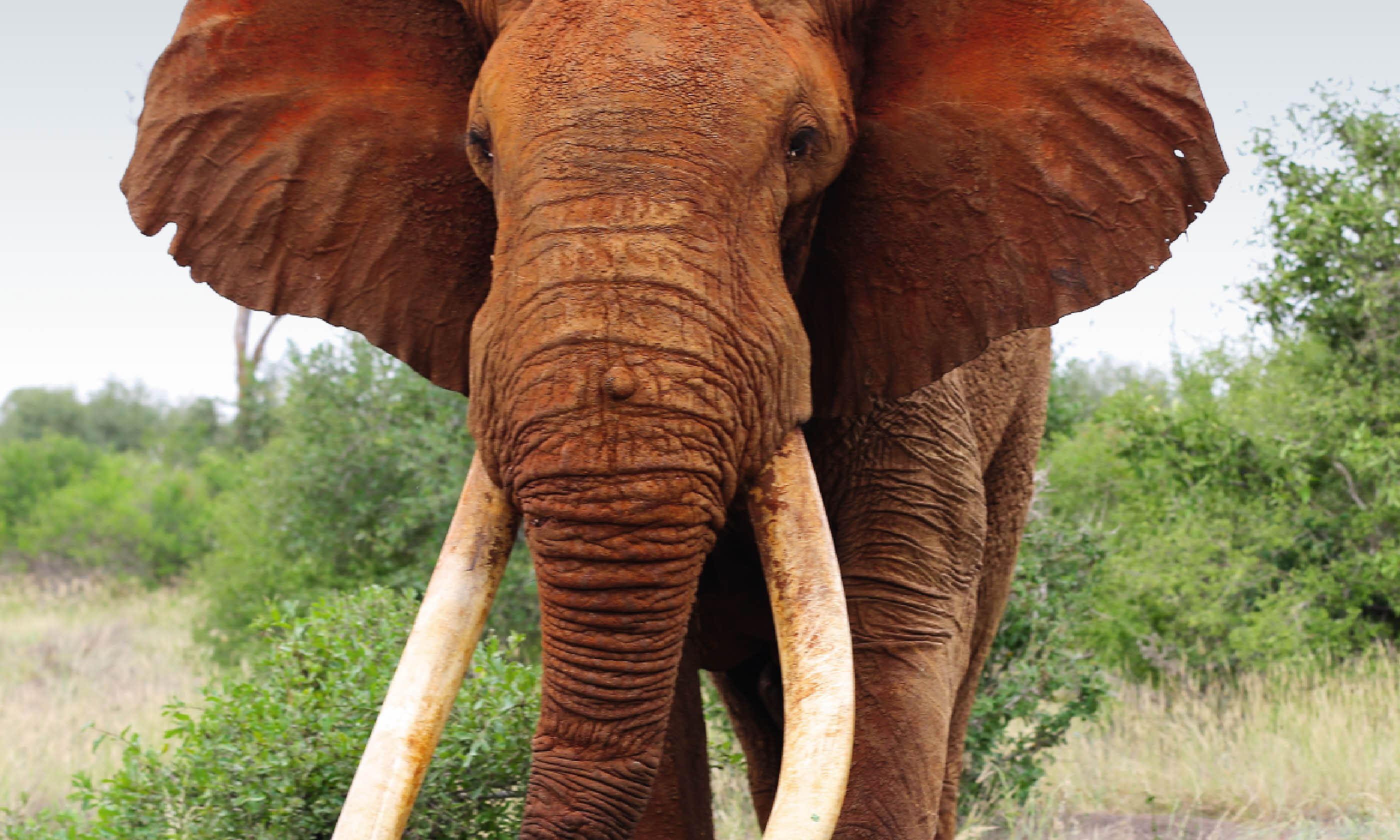
Protecting the elephants of Tsavo National Park
Tsavo is supposed to be a safe haven for Kenya's elephants, but with poaching on the rise can this national park keep its mighty tuskers safe? Brian Jackman investigates
Animal obituaries rarely make global headline news. But it happened last year, when the Tsavo Trust reported the death of Satao, Kenya’s biggest and best-loved elephant, killed by a poacher’s poisoned arrow on 30 May.
Satao was one of Kenya’s last giant tuskers – magnificent old bulls carrying ivory weighing upwards of 45kg per side. In the whole of Africa there are no more than 40 of these ‘100 pounders’, of which perhaps a dozen are found in Tsavo National Park.
Satao was born in the late 1960s; in his prime this rust-red behemoth was observed with awe by the thousands of visitors fortunate enough to catch a glimpse of him as he roamed through the bush. His tusks were so big they almost dragged on the ground, and inevitably he became a target for poachers.
Throughout the 18 months before his death the Kenya Wildlife Service (KWS) and the Tsavo Trust had been monitoring Satao’s movements. However, the area he frequented covers at least 1,000km of near-trackless bush and the poachers only had to get lucky once. When at last his body was discovered his killers were long gone, taking with them his two-metre-long tusks to feed the demand for ivory on the other side of the world. “A great life lost so that someone far away can have a trinket on the mantelpiece,” said Richard Moller, the man who found Satao’s carcass.
Moller is a man on a mission. He is the Chief Conservation Officer of the Tsavo Trust, a not-for-profit organisation operating alongside KWS to provide extra protection for the park’s beleaguered elephants. Having previously spent ten years conducting anti-poaching operations at the Lewa Wildlife Conservancy in northern Kenya he is more than qualified for the job and is also a veteran bush pilot with over 3,000 hours of low-level flying under his belt.
Nowadays most of his aerial reconnaissance is carried out on behalf of the Trust’s Big Tusker Project, keeping watch over what is arguably the world’s last viable gene pool capable of producing elephants with exceptionally heavy ivory. With tusks such as Satao’s currently worth anything up to US$1 million in China, their survival is threatened as never before. “Make no mistake,” warns Moller, “unless their future is secured today they will be gone forever.”

Hanging with the herd
In October I joined Moller on one of his regular patrols over Tsavo. We took off at first light in his two-seater Piper Supercub, a 52-year-old bush plane that had once belonged to Bill Woodley, one of Tsavo’s most revered wardens.
From my seat, riding pillion behind Moller in his cramped cockpit, I watched our shadow skimming over the ground less than 60m below. Ahead of us, bounded by the distant walls of the Yatta Plateau, lay an eternity of thorn bush; spread out in every direction I could see Tsavo’s terracotta elephants moving slowly towards a horizon so wide and far away it looked like the edge of the world.
For six months the park had lain gasping under the sun while the
kaskazi (the dry season tradewind) had poured across the land. But two days before my visit a sudden storm had blown in from the Indian Ocean, bringing the ashen bush back to life. The elephants, every one the same earthy colour as the red murram game trails they followed, now stood out sharply against the greening plains.
For two hours we flew, and must have seen at least 1,000, including a 300-strong breeding herd. At one point we zoomed low over a poachers’ hideout buried deep in the trackless commiphora scrub, but the poachers themselves were nowhere to be seen. Then at last Moller spotted what we had been looking for: five enormous tuskers, all carrying heavy ivory. In all my years in Africa I had never seen elephants to match them, not only for their tusks but their sheer body size.
The biggest bull was well known to Moller. “Give him another five years and he could become another Satao,” he shouted over the headphones. Already his tusks almost reached the ground, and as we circled overhead he thrust them into the bushes as if to hide them. “It’s almost as if they know it’s their ivory that is getting them killed,” yelled Moller.
Now, having pin-pointed Satao’s successor from the air, it was time to track him down on the ground – no easy task in a wilderness twice the size of Israel. We left the Supercub battened down on the airstrip and set off by Land Cruiser into the yawning emptiness of the plains.
Elephant country
All elephants need space and it was primarily for them that Tsavo became East Africa’s biggest national park. It is so big that it is administered as two separate parks, with Tsavo West on one side of the Nairobi- Mombasa road and Tsavo East on the other. The 13,747 sq km expanse of Tsavo East, over which we had been flying, is a purist’s park. Once you leave the Galana River and its colonnades of shady doum palms it becomes a sun-stricken wilderness with only a solitary giraffe or a faraway view of shattered hills to break the infinity of the plains.
In places it is crossed by bone-dry
luggas, seasonal watercourses whose thorny thickets are a favourite hiding place for lions. But these are not the indolent pussycats that pose for tourists on the Masai Mara’s lush green savannahs. They are lions with attitude – some of them quite possibly descendants of the notorious ‘man-eaters of Tsavo’ that preyed on the workers building the Nairobi to Mombasa railway line in 1892.
But above all, Tsavo is classic elephant country. Its sheer size – though a nightmare to patrol – is also its greatest strength and here, it was hoped, the herds might wander freely and at peace. Sadly, that was not to be. By the 1960s their numbers had swelled to around 35,000, giving rise to demands that they should be culled to save the park’s vegetation from destruction; but the savage five-year drought that ravaged Tsavo in the early 1970s put paid to that. By the time it was over more than 9,000 elephants had died, and as the price of ivory soared, the survivors became a prime target for the poachers.
In the beginning the main culprits were the Waliangulu, a small tribe of hunter-gatherers also known as the People of the Longbow, whose bows were more powerful than those used by the English at Agincourt, and whose arrows – fletched with vulture feathers – were dipped in a lethal tarry substance brewed from the Acokanthera shrub for which there is no antidote.
The Waliangulu in turn were ruthlessly displaced by the
shifta – heavily armed poaching gangs who swept down from Somalia. Their weapon of choice was the AK-47 and the elephants died in the thousands. By 1988 large areas of Tsavo were considered too dangerous for tourists and placed off limits as soldiers, police and anti-poaching patrols engaged the Somali ivory gangs in bloody skirmishes.

I went anyway, to report for
The Sunday Times on the poaching war that was turning the park into an elephants’ graveyard. Carcasses lay everywhere. To find them one had only to follow the vultures, and the stench of death hung in the air like a curse. At one spot an entire family of six elephants had been machine-gunned on their way to water. The matriarch had collapsed in a kneeling position, lying with her huge ears still spread as in life, a grotesque parody of an elephant with her trunk chopped off and her tusks hacked out.
The worldwide ivory trade ban imposed in 1989 came just in time to save the Tsavo herds, reduced by poaching to an all-time low of 6,000 animals. The ban brought a few years’ respite in which the population increased to about 12,000, representing one-third of all Kenya’s elephants. But today the poachers are back with a vengeance. The price of ivory has gone through the roof. KWS is struggling to hold the line and Richard Moller continues to watch over the tuskers on his endless aerial patrols.
Six tons of power
Although it was the tuskers that had lured me back I was thrilled to return to the big game stronghold I had not seen for nearly a decade. How could I have forgotten what a wild and hugely underrated park it is? Yet compared to the Masai Mara it receives far fewer visitors and much less press coverage.
Troops of oryx, horns glinting in the mid-morning sun, cantered off as if running for the sheer joy of being alive. A solitary bull buffalo rose dark and glistening from a roadside wallow. Exquisite golden pipits scattered like butterflies in our wake, and whenever we stopped I was aware of a silence so profound I could even hear the whir of sunbirds’ wings as they sucked nectar from the sweet-scented acacias.
Tsavo’s harsh beauty shone all around us, its wildness and freedom undiminished, yet the cruelties inflicted on its dwindling herds still clung to its hills and plains like the taint of an old kill. And the poachers were still out there, biding their time.
We drove all day, the red dust pluming in our wake, and never saw another vehicle. Kenya’s tourist trade was still reeling from the terrorist outrage in September 2013 that left at least 67 people dead in Nairobi’s Westgate shopping mall. Even Tsavo felt its malign effect: on two days in 2014 not a single visitor entered the park – the first time such a thing had happened since the park was established in 1948.
But if visitors were scarce the elephants’ presence was all around us. Giant footprints and dung piles revealed where herds had crossed the road in the night, leaving their unmistakable stable-yard smell in the air. The elephants we encountered appeared ill at ease, seldom allowing us to approach too closely before high-tailing off into the bush.

Then miraculously, after I had almost given up hope of catching up with the five bulls we had seen from the air, we spotted them moving in line across a low ridge ahead of us. Moller instantly recognised the biggest bull by the way its tusks were curved like callipers. “I’ll try and get in front of them,” said Moller. “That way we might get them to walk up to us.” Slowly he edged the vehicle forward in a wide arc and then stopped when the elephants were still some 200m away.
Cautiously they drew closer, the big bull in the lead, ears spread wide and trunk held high as if already vaguely aware of our presence until he was looming over us, six tons of unimaginable power. In awe I stared up into his unblinking brown eyes and wondered what secrets lay hidden behind those shrunken temples.
For more than three decades he had roamed across the Tsavo ecosystem, surviving droughts, avoiding poachers, and in all that time the polished ivory that had been the downfall of so many of his comrades had continued to grow. If he were lucky enough to be spared, his tusks would continue to grow heavier with each passing year and he would indeed become a worthy successor to the legendary Satao, a living monument to a vanishing world.
For a moment longer he continued to confront us, one massive foreleg swinging to and fro in indecision. Then he and his companions caught our wind. With a sudden shake of their heads they whirled around and were gone, melting away into Tsavo’s illimitable thickets.
The author travelled with Expert Africa. Its eight-night Big Tusker safari includes three nights at Campi ya Kanzi in the Chyulu Hills and four nights in Tsavo East (two at Galdessa, two at Satao Camp). The itinerary includes private flights and road transfers, full-board accommodation and the services of a private safari guide in Tsavo East. The itinerary can be tailormade for individual dates and preferences.
All images by Tsavo Trust



